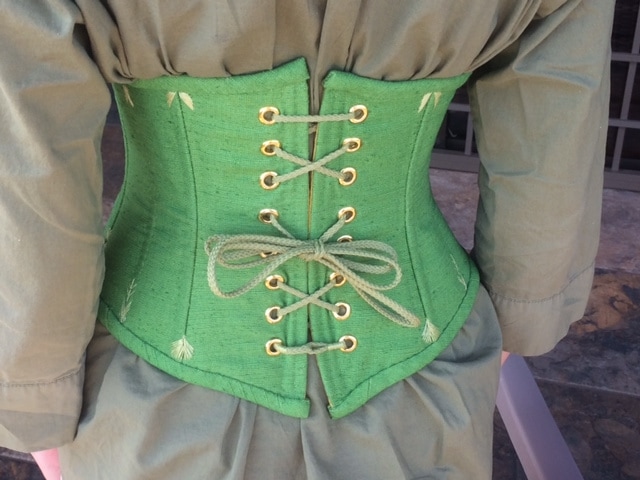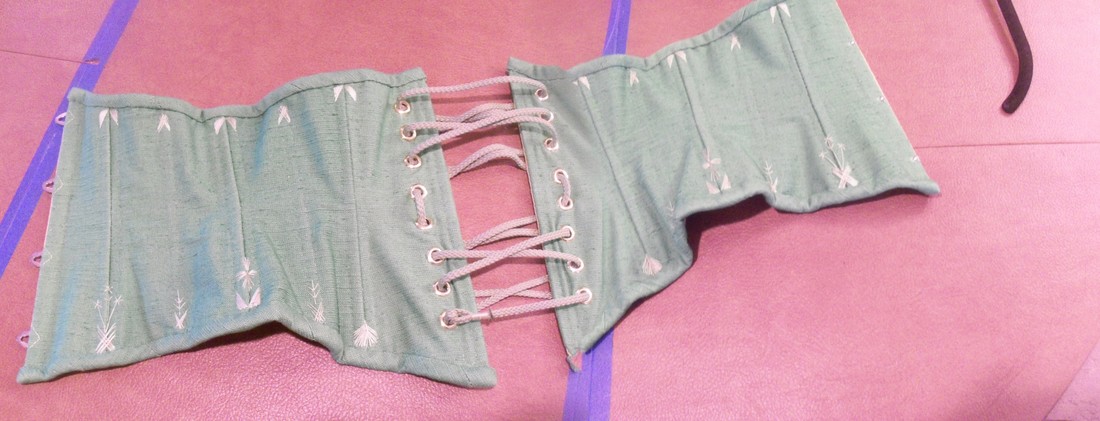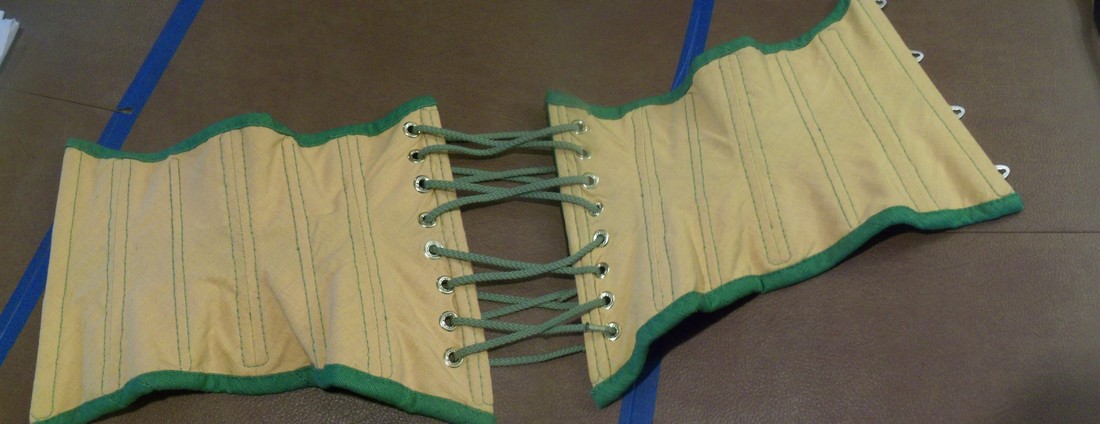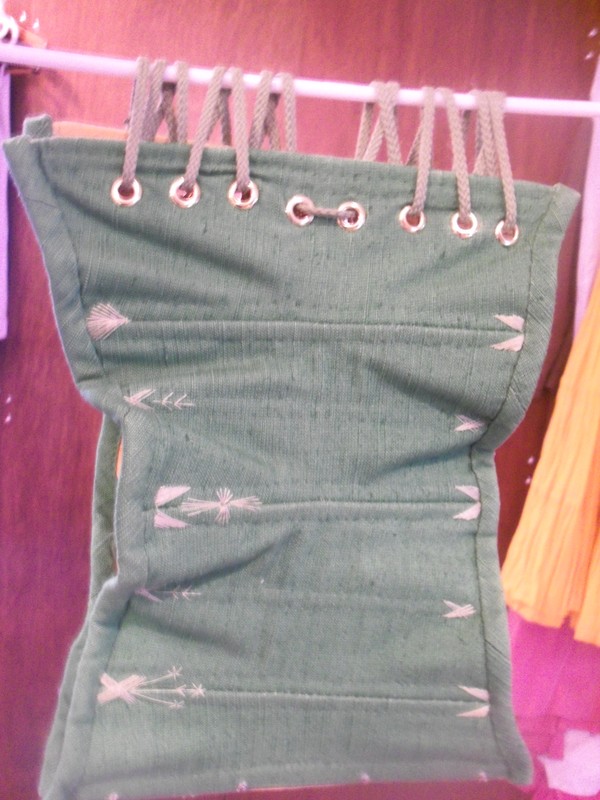THE PATTERN I downloaded the pattern, and found it fit me perfectly. However, it was drawn for someone with a lot of sewing know-how, since lots of basic things were not marked on the pattern. I encountered the following problems (solutions in parentheses). Since it's been several years since I downloaded the pattern, these problems may have been fixed by now.
CONSTRUCTIONI could not afford coutil, so instead used canvas for the inside, and thick cotton for the outside and for the lining. I cut the fashion fabric and canvas on the straight, and cut the lining on the bias, thus making it so that there was always stability in at least one layer, no matter how the several layers were pulled. The result is pretty sturdy, but also heavy... more of a winter corset! The fabric is all cotton, except for the waist tape inside, which is polyester grosgrain ribbon. I burned the edges of the ribbon to keep it from fraying. The waist tape is in between the layers. The bones are spring steel, tipped with plastic on one side, but cut to length on the other side, so exposed steel. I did my best to file the cut edges smooth by rubbing them on the concrete sidewalk. I made sure all the cut edges were at the bottom of the corset, so if they eventually rust, at least it'll be in a section that I can cover easily with a skirt or trim. However, I will try to prevent rust by careful wear and by dry cleaning instead of washing. My only concern is for the sharpness of the cut ends, which I did not get entirely smooth... I hope they don't cut through the ends of the channels. I hand-sewed the whole thing, using running stitches for the seams, backstitches for the boning channels, hand embroidery for the flossing, and slip stitches for the bias tape binding. The cost was around $12 US. The green fashion fabric with its slubby surface was a $1 find at a vintage/junk shop. The inner canvas and the yellow lining were gifts from someone else's stash. The boning cost $0.25 per bone ($5 total), and the busk and grommet set were about $3 each. The cord for lacing was valued in cents, and the ribbon and thread were from my stash. The thing took nearly a month to finish, though, working intermittently. WEARING THE CORSET There are many myths about corsetry. To hear some people tell of the woes of Victorian women, you'd think corsets were some kind of torture device that held half the human race in bondage. But when you consider that corsets, in some form or another, are the longest-running female undergarment in western history, it's hard to believe they could be all bad! And while Victorian corsets had a different shape than the stays and bodices of previous centuries, there's little to indicate that they were dramatically worse for the wearer's health. However, the myths do have some roots in reality, so let me address them in the light of my own corset wearing experience. Yes, the corset does prevent me from bending at the waist. So that's a reduction in mobility. On the other hand, modern back braces for construction workers do exactly the same thing, and it's considered a good thing since it prevents back injury due to improper lifting. When wearing a corset, you have to lift with your knees, not your back. The pitfalls of this are exactly the same as the pitfalls of wearing a back-brace: if you wear it every day, your back muscles get weaker because you're not holding yourself upright. So: the corset is not a crippling device, but Pilates is a better option for improving your posture. I wouldn't wear a corset every day, because I wouldn't want my muscles to atrophy. (This photo of William Morris with family and friends shows the slumped posture of women who'd been in corsets their whole lives going without them.) Yes, it does reduce my lung capacity: I breath more shallowly, using only the upper portion of my lungs. If I had a tendency toward bronchial infections, this could be very bad (never using the lower lungs could easily cause bacteria to collect there), but since I have healthy lungs, there's no problem. Sneezing in a corset feels bizarre, though! And the "heaving bosom" is totally a thing when your diaphragm is compressed. (Corsets made for stage productions for operas and such are more like corset-shaped breastplates, made with elastic backs and not snug-fitting, so the singers can actually sing!) Yes, it does make me eat less and have to use the toilet more frequently. This, and the reduced lung capacity, are logical effects of wearing something constricting around the abdomen. No, I don't faint from wearing a corset. But then, I'm not tightlacing. My unbound waist is 27''. When the corset is fully laced, my waist + corset measures 25.5'', a 1.5'' reduction (less than 10%). That's typical for a light-lace corset... it creates an hour-glass silhouette by making the waist into a circle instead of an oval and pushing some skin up or down. No, this one is not painful to wear. In fact, it's quite comfortable, like a firm hug. And if I have back pain before I put it on, it feels great. On the other hand, I have tried a commercially made over-bust corset that was very painful to wear, because it was made for a normal waisted woman and I am high waisted. That's a fit issue, not an all-corsets-ever issue. Basically, the narrowest part of the corset ought to correspond with your natural waist, which is where you bend from. That way when you move naturally, the corset stays in place. If the narrowest part of the corset is significantly lower than your natural waist, then the corset has to choose between riding up (which it can't do because of breasts and armpits being in the way), or pushing your body down (which it can't do because of your hip-bones). In the case of the commercially made corset I tried, it felt like it was actually trying to break my pelvis with downward pressure. Not fun. I took it off after five minutes. So: corsets aren't painful if they fit you. They can be painful if they don't fit you. Much like bras or shoes. UNEXPECTED BENEFITS It's very warm, so that even in the winter, I can wear an off-the shoulder gown and not feel cold, because there are so many layers around my torso. It does an excellent job of re-distributing the weight of lots of skirts and petticoats, so they don't cut into my waist painfully. This works well, since the bigger skirts give the illusion of a tiny waist without actually having to lace it tiny. I wouldn't want to wear large heavy skirts without some kind of boned waist. In sum, the effects of wearing a normal (not tight-lacing) corset are slight lifestyle changes with small health consequences. Going without a corset is healthier, but wearing one isn't worse than wearing high heels or tight jeans today. SO DID VICTORIAN WOMEN TIGHTLACE? Some certainly did, but not as many as we've been told. For instance, extant dresses in museums rarely have the 16" to 18" waists that people claim to have attained. And though corsets were sold that measured that size, they weren't usually laced all the way closed. Some gap in the back of the corset is normal, for ventilation. Lots of girls proudly bought tiny corsets who didn't lace them all the way shut, just as lots of girls today buy "size 0" from stores which have simply re-labeled all their sizes down to appeal to vanity. Photographs from the Victorian era rarely show extremely small waists. To give you an idea of normal, consider that my neck is 13.5" and my waist 27", so if I laced down to an 18" waist, it would be more comparable to my neck than to my real waist. Now look at old photos... are there any women with necks and waists of comparable size? Even in a gallery of "famous tightlacers" I see many with corseted waists that look like my un-corseted one. If I padded my bosom and hips like they did, I'd have an hourglass figure like theirs too. Other pictures are of women whose waists truly were tiny, but their lives show such mental disorder that I think their tightlacing was probably comparable to eating disorders today: not the norm, and certainly nothing to emulate. Many "tightlaced" photographs from the past are rather obviously edited (this photo of Polaire couldn't be more fake, if you ask me). And that brings us to the question of tight-lacing as a fetish: in the Victorian era, when control over women was a societal value, some people (male and female) took corsetry (or just the idea of it) to extremes. They wrote heated fantasy stories about cruel mistresses in finishing schools employing draconian methods to reduce the girls' waists to medically impossible sizes, or stories of strict husbands requiring their wives to submit to gradually tighter and tighter corsets for "discipline". These stories often ended with testimonials about how much happier the women were with their new, neat figures, and how they were the envy of all the neighborhood, and how their husbands were so proud of them even though they couldn't do anything but lie on the couch all day, and so on. ("Isn't being completely controlled just marvelous, Gertrude? Aren't you more fulfilled as a woman now that a man has taken charge of your breathing and digestion? Oh!" Modern corset erotica is pretty similar.) Photographs of women with tiny waists were often edited by painting out the real sides of the waist on the negatives to make the waist appear tinier, and were sold for titillation, in the same way as pornographic pictures today. Just as some Victorians fetishized body modification and control, other people (principally doctors) held tight-lacing up as a sign of female weakness and folly, and crusaded against corsets as "killers" of women and unborn babies. Did they sincerely believe that corsets were deadly? Maybe some of them did. Did they also believe that women shouldn't be allowed to make decisions about their own clothes, and that wiser male heads should prevail? I think so. The rhetoric they used against corsetry was often in terms decidedly against women, who were proclaimed to be "slaves of fashion", lacking good sense or education, or "iniquitous". Corsetry was a catch-22 for women in the Victorian era: you couldn't go without because that was indecent, morally suspect, shameful, ugly, et cetera, yet the fact that you wore one was also taken as proof of your weakness (women were thought to be incapable of good posture without corsets) and imbecility (you could easily go too far and kill yourself because you were so vain and silly). Does any of this sound familiar? Sort of like the catch-22 messages we get today about wearing make-up, having big breasts (by nature or augmentation), or wearing high heels? Women have been dealing with judgemental nonsense for a long time. The Wikipedia article about the Corset Controversy is a fun read! If nothing else, it shows that argument on any subject usually leads to the various sides entrenching more deeply in their own beliefs, and that nothing gets people more riled up than other people making different choices from them! LONG TERM WEAR & TEAR, AND STORAGE
4 Comments
The Sister
5/22/2017 11:47:40 am
This was an interesting read! Your comments on tightlacing made me think of Samantha Barks' teeny tiny waist, visible in various productions of Les Misrables (here, for example http://www.imdb.com/name/nm2885819/mediaviewer/rm3393959168). I'm quite sure hers is naturally small, for she is a very petite, fine-boned woman.
Reply
Yes, and when we hear Samantha Bark sing it is clear that her lung capacity and diaphragm are in no way compromised, so she can't be wearing a corset. Really dedicated singers consider their bodies entire to be their instruments, and wouldn't impair their powerful chest and belly movements with coutil and steel.
Reply
The Sister
5/24/2017 01:11:24 pm
It certainly did seem a point of pride, proof of self-control in eating habits and exercise. Consider Scarlett O'Hara and her attempts to reduce her waist after childbirth, which is entirely unhealthy considering how long it naturally takes for the womb and abdominal muscles to recover and re-strengthen. I can understand regular corsetry as a part of an era's fashion, but I think that most women probably were very reasonable and didn't take "extreme" measures.
Sue
5/14/2023 01:48:05 am
That would have been Charles Ingalls putting his hands around his wife's waist, not her son-in-law, Almanzo Wilder years later. Leave a Reply. |
Karen Roy
Quilting, dressmaking, and history plied with the needle... Sites I EnjoyThe Quilt Index Categories
All
Archives
March 2024
|





 RSS Feed
RSS Feed